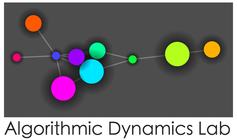Decoding and Reprogramming LifeWe aim to significantly expand our understanding of the causal mechanisms underlying natural and artificial systems and to develop new tools to offer new mechanistic insights into the nature and sequence of molecular events inherent to cellular reprogramming..
Algorithmic Information Dynamics is an exciting new field put forward by our lab based upon some of the most mathematically mature and powerful theories at the intersection of computability, algorithmic information, dynamic systems and algebraic graph theory to tackle some of the challenges of causation from a model-driven mechanistic perspective, in particular, in application to behavioural, evolutionary and molecular reprogramming. Current and future research directions include: algorithmic feature selection, algorithmic model generation; connections between spectral graph theory and algorithmic complexity; the study of non fine-tuned models of causal networks; and applications of our algorithmic calculus to disentangling interconnected multilayered networks. |
|
One year before passing away, Marvin Minsky, widely considered the founding father of Artificial Intelligence, described what turns one of our main conducting lines of research. Together with Sydney Brenner's direction — the 2002 Nobel prize in Physiology or Medicine laureate awarded by the Karolinska Institute -- it completes the picture of what our lab strives: |
It seems to me that the most important discovery since Gödel was the discovery by Chaitin, Solomonoff and Kolmogorov of the concept called Algorithmic Probability which is a fundamental new theory of how to make predictions given a collection of experiences and this is a beautiful theory, everybody should learn it, but it’s got one problem, that is, that you cannot actually calculate what this theory predicts because it is too hard, it requires an infinite amount of work. However, it should be possible to make practical approximations to the Chaitin, Kolmogorov, Solomonoff theory that would make better predictions than anything we have today. Everybody should learn all about that and spend the rest of their lives working on it. |
Biological research is in crisis, and in Alan Turing’s work there is much to guide us ... Although many believe that ‘more is better’, history tells us that ‘least is best’. We need theory and a firm grasp on the nature of the objects we study to predict the rest ... The concept of the gene as a symbolic representation of the organism — a code script — is a fundamental feature of the living world and must form the kernel of biological theory. |
Online course on Algorithmic Information Dynamics now open
A Computational Approach to Causality and Molecular Biology: From Complex Networks to Reprogramming Cells
Almost 300 people have already enrolled in only the first 3 days. Enrol here.
A Computational Approach to Causality and Molecular Biology: From Complex Networks to Reprogramming Cells
Almost 300 people have already enrolled in only the first 3 days. Enrol here.
Course poster and trailer:
ABOUTThe Algorithmic Dynamics Lab is a spinout of the Unit of Computational Medicine and is the result of a long-term collaboration between researchers in complexity science, information theory, dynamical systems, network science, machine learning, and computational biology with common interests in fundamental science and applications to the natural sciences, in particular genetic and molecular biology.
Our aim is to introduce and exploit the most mature mathematical theories into the life sciences to bear mature concepts (such as multi-scale dynamics, spectral theory, and algorithmic inference) in solving some of the most pressing problems in the areas of systems modelling. Our logo illustrates the type of phenomena we aim to help disentangle. The graph is described in paper J24 and its generating mechanism is a simple, recursive short computer program, yet it produces a network with complex graph-theoretic and some apparent random statistical properties. For example, the graph displays maximal Shannon entropy when described by its degree sequence and measures by an uninformed observer but minimal Shannon entropy when looking at its adjacency matrix thereby showing the failure of statistical mechanics approaches and of computable measures in general such as Entropy to characterise causal non-random macroscopic systems. |
SISTER LABSOn the one hand, our sister Living Systems Lab led by Prof. Jesper Tegnér at KAUST is setting up a 3 million USD state-of-the-art lab with the latest equipment for single cell sequencing and in vivo manipulation technology to steer and reprogram single cells using the reprogramming methods that we have developed at CompMed and AlgoDyn. The cell lines and organisms to be used are stem cells, immune cells and cancer cells.
On the other hand, the Algorithmic Nature group has developed some of the main numerical methods at the core of the conceptual framework that is fuelling our pursuit of a better understanding of the causal mechanisms and first design principles of natural and artificial evolving systems, including a sophisticated online calculator that provides estimations of algorithmic complexity and logical depth by way of the powerful concept of algorithmic probability that combines traditional probability with computation. We continue to foster and nurture connections between our sister labs in order to further the development of such numerical and conceptual methods as well as to explore aspects of animal and human behaviour from this algorithmic and powerful perspective (see paper J23). |
PEOPLE
|










